Throughout history, Buddhism has been deeply rooted and flourished in Vietnam. Therefore, it’s no surprise that our country boasts numerous unique and sacred architectural marvels from the Buddhist tradition. Whether you’re a devout follower or not, chances are you’ve at least once visited and experienced the serene atmosphere of a temple, right?
Among the diverse temples today, the Bai Dinh Pagoda complex stands out with its distinctiveness and the honor of holding many records in the region and continent. So, if you find yourself in Ninh Binh or simply seeking tranquility for your soul, visiting the ancient Bai Dinh Pagoda is a must! And with the support from Vietnampeace.com, your journey to this spiritual haven will surely be enhanced.
1. A Brief Overview of Bai Dinh Pagoda’s History and Scale
A Glimpse into Bai Dinh Pagoda’s History
Over a thousand years ago, during the feudal dynasties of Dinh, Pre-Le, and Ly, Buddhism was highly esteemed and considered the national religion. Consequently, numerous ancient temples were constructed, including the Bai Dinh Pagoda, situated amidst the Trang An mountain range. While its origins trace back to the Dinh Dynasty, the pagoda retains architectural details and relics from the Ly Dynasty era.
Located in a region believed to be blessed with natural marvels according to Vietnamese folklore, Bai Dinh Pagoda sits on land imbued with historical significance. It was once where Emperor Dinh Tien Hoang held ceremonies to pray for favorable weather. King Quang Trung conducted flag-raising rituals to motivate his troops before heading to Thang Long to repel the Qing invaders.
In 1997, Bai Dinh Pagoda was recognized as a national historical, cultural, and revolutionary relic. With its unique and sacred attributes, the pagoda welcomes many visitors and Buddhist pilgrims annually. If you ever get the chance, experience the extraordinary land of Bai Dinh.
Unique Architecture of the Bai Dinh Pagoda Complex
To this day, the Bai Dinh Pagoda complex comprises both ancient and newly constructed sections, with the latter initiated in 2003. Perched majestically on the mountainside amidst the backdrop of a serene lake and rugged cliffs, the pagoda notably sits at the western gateway to the ancient capital of Hoa Lu.
With over a millennium of history, the pagoda’s architecture proudly showcases the distinctive beauty of ancient times. Despite the presence of the newer section, characterized by its exquisite design and scale, it harmonizes seamlessly with traditional aesthetics.
Upon arrival, you’ll be greeted by a serene and refreshing ambiance. Passing through the gates, you can stroll along corridors adorned with statues of arhats encircling the temple grounds. Numerous small gardens feature lush greenery, notably the sacred bodhi trees imported from Indian temples.
More than just a religious site, Bai Dinh Pagoda has evolved into a renowned eco-tourism and spiritual destination. It has garnered eight records in Vietnam and Asia, including:
– The largest bronze bell in Vietnam
– The tallest and heaviest statue of Buddha Shakyamuni in Asia
– The most extensive set of bronze statues of Tam The (the Buddhas of the Three Times) in Vietnam
– The giant bronze statue of Buddha Maitreya in Southeast Asia
– The longest corridor of Arhat statues in Vietnam
– The highest number of bodhi trees in Vietnam
Admission Fees
If you’re visiting for prayers, religious activities, or simply exploring, don’t miss out on the opportunity to tour Bai Dinh Pagoda. Given its vast premises and connection to the Trang An scenic landscape, you can combine various excursions and utilize related services, with costs as follows:
– Electric car rental: 30,000 VND/one-way
– Trang An scenic tour: A boat ride ticket costs 150,000 VND/person
– Electric car ticket: 60,000 VND/person
– Bao Thap sightseeing ticket: 50,000 VND/person
– Tour guide fee: 300,000 VND/tour
2. Transportation and Accommodation for Visiting Bai Dinh Pagoda
Transportation Options
The pagoda is located in Gia Sinh commune, Gia Vien district, Ninh Binh province, about 12km from the center of Ninh Binh city and approximately 100km from the capital city of Hanoi. Therefore, if you want to visit Bai Dinh Pagoda, you have plenty of transportation options to suit your needs.
You can opt for flights, trains, or buses for travelers from afar. You can use personal vehicles or hire a car service for convenience if you’re nearby.
Accommodation Options
Inside the pagoda, there’s Bai Dinh Guesthouse, offering ancient yet elegant architecture and providing a serene retreat for travelers from all corners who visit Bai Dinh Pagoda. You can also find and book hotels nearby for easier access to recreational activities.
Activities and Places to Visit Inside the Pagoda
Daylight Illuminates, Darkness Envelopes
Although the cave extends about 25 meters deep and 15 meters wide, it still receives ample natural light. Inside, you’ll find the statue of Buddha, and at the end of the cave, you can turn to the sacred shrine of Cao Son. In the middle, a natural well keeps the atmosphere relaxed. Here, people pay homage to ancestors and celestial beings.
Temple of Saint Nguyen
Within the Bai Dinh Pagoda complex, there’s a temple structured in a pre-and post-court style. This is where the famous monk and physician Nguyen Minh Khong is revered and remembered for his contributions. He accidentally discovered the beautiful cave and initiated the construction of the pagoda.
Additionally, he was a renowned healer, not to mention his efforts in researching the origins of the Dong Son civilization in ancient Vietnam, aiming to revive the traditional bronze casting craft that had dwindled over time.
Temple of Cao Son Deity
The temple dedicated to Cao Son Deity is nestled against the mountain, with a corridor separating it from the valley in front. Legend has it that during the construction of the Hoa Lu capital, Emperor Dinh Tien Hoang built three temples to worship the deities guarding the three gates of the capital, with Cao Son Deity guarding the western gate. So, when visiting Bai Dinh Pagoda, pay homage to the Cao Son Deity.
Cave of Maternal Worship
Continuing your journey, visit the cave dedicated to Saint Mother Lieu Hanh, a saint and a mortal. The cave temple comprises seven interconnected chambers. In the middle of the cave is the “single pillar reaching the sky,” formed by stalactites. Moreover, the cave emits enchanting sounds resembling a symphony from stone instruments.
Ngoc Well
Legend has it that the monk Nguyen Minh Khong fetched water from this well to make medicine for the king and the people. Looking down from above, you’ll see a surface of emerald-green water surrounded by lush trees within the vast courtyard.
Exploring the Record-Breaking Structures of the Pagoda
When touring Bai Dinh Pagoda, visit the structures that have set records for the pagoda. Among them, the first to mention is the largest bronze bell in Vietnam, weighing up to 36 tons. The bell is intricately carved with exquisite and unique artistic patterns.
Furthermore, if you wish to make it, don’t miss out on visiting the giant statue of Thich Ca Buddha in Asia, which is solemnly placed within the pagoda’s main sanctuary. Weighing 100 tons and standing 9.5 meters tall, the statue exudes magnificent splendor.
Main Sanctuary of Bai Dinh Pagoda
To express your aspirations and wishes, visit the Main Sanctuary of the pagoda to convey them to the Buddha. In front of the sanctuary lies a spacious courtyard with a serene pond in the center, which you can visit and admire.
Precautions Before Visiting Bai Dinh Pagoda
The best time to visit the scenic area and the ancient Bai Dinh Pagoda complex is from January to March in the lunar calendar. On the 6th day of the Lunar New Year, the pagoda hosts the Bai Dinh Pagoda Festival, so you can combine sightseeing with participating. Additionally, visit the pagoda on any regular day to enjoy a peaceful atmosphere.
Moreover, because it is a sacred place when visiting Bai Dinh Pagoda, you should pay attention to:
Dress modestly and comfortably, choosing appropriate attire for walking.
Depending on the weather conditions, consider bringing an umbrella.
Be cautious of theft, especially during crowded times.
As a profoundly significant architectural masterpiece with special spiritual significance, and with all that Bai Dinh Pagoda has achieved, it’s a place that all of us should visit at least once in our lifetime. Whether you’re a Buddhist or a traveler, near or far, you’ll find convenient conditions to see with the support from Vietnampeace.com!
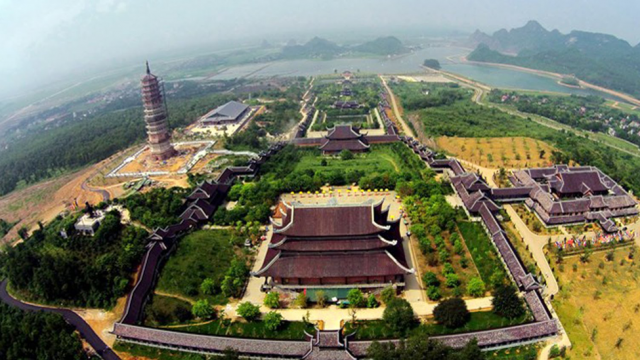
Overview of Bai Dinh Pagoda (Photo: Collection)
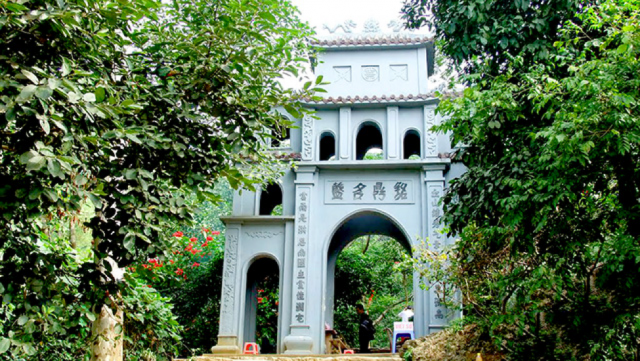
Entrance to the ancient temple pagoda (Photo: Collection)

The palace consists of 3 floors of 13 massive roofs (Photo: Collection)
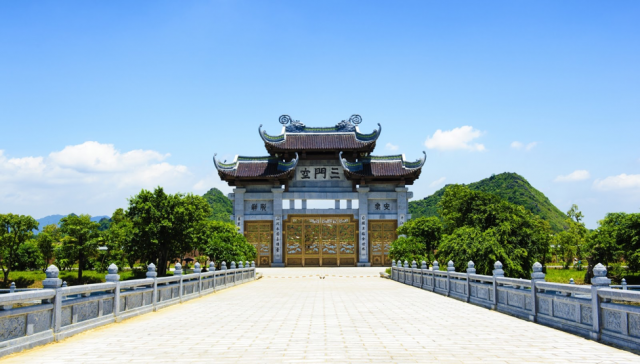
Three pagodas from the inside look out (Photo: Collection)
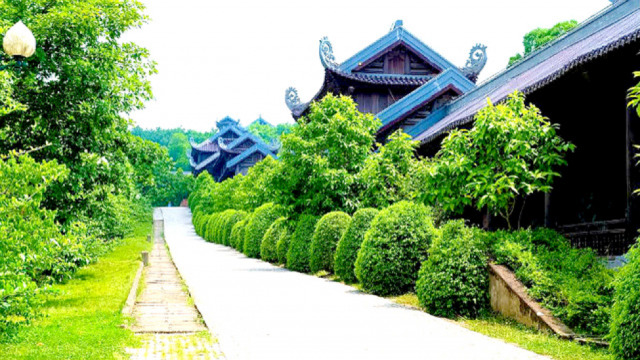
Green space with air conditioning (Image: Collection)
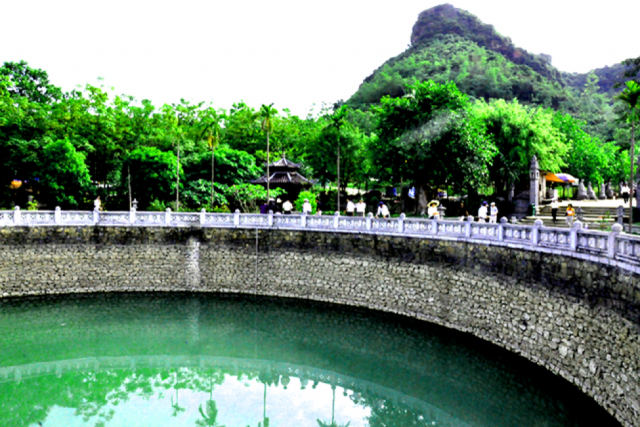
Blue healthy water is like jade (Image: Collection)
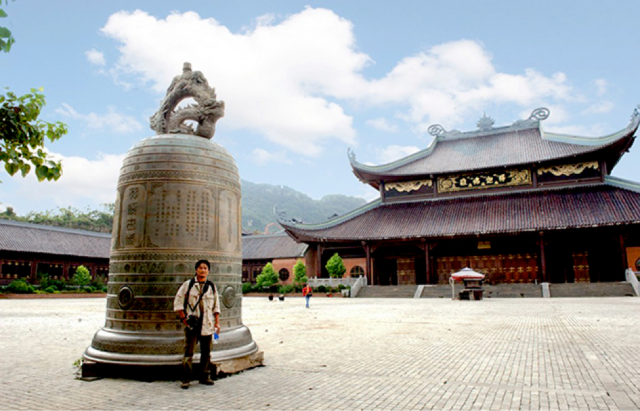
The largest bronze bell in Vietnam (Image: Collection)
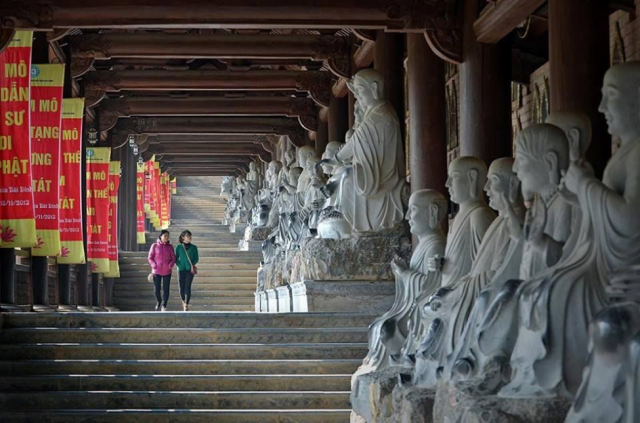
The longest La Han corridor in Vietnam (Image: Collection)
